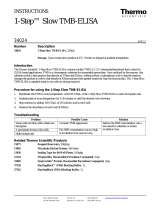Page is loading ...

INSTRUCTIONS
Pierce Biotechnology
PO Box 117
(815) 968-0747
www.thermoscientific.com/pierce
3747 N. Meridian Road
Rockford, lL 61105 USA
(815) 968-7316 fax
Number Description
37069 SuperSignal ELISA Pico Chemiluminescent Substrate
Contents:
SuperSignal ELISA Pico Luminol/Enhancer Solution, 125mL
SuperSignal ELISA Pico Stable Peroxide Solution, 125mL
37070 SuperSignal ELISA Pico Chemiluminescent Substrate
Contents:
SuperSignal ELISA Pico Luminol/Enhancer Solution, 50mL
SuperSignal ELISA Pico Stable Peroxide Solution, 50mL
Storage: Upon receipt store product at room temperature. Product shipped at ambient temperature.
Introduction
The Thermo Scientific SuperSignal ELISA Pico Chemiluminescent Substrate is for luminometer-based applications. This
substrate is specific for peroxidase labels (e.g., horseradish peroxidase [HRP]) in ELISA procedures. The unique enhancer in
this substrate results in rapid kinetic light output and high-signal intensity that lasts for up to 30 minutes (Figure 1).
Important Product Information
• SuperSignal ELISA Pico Substrate is sensitive. Optimization of the antibody, antigen and HRP-conjugate concentrations
is required.
• To limit nonspecific signal caused by cross-reactivity with antibody and the blocking reagent, empirical testing is
essential when choosing an appropriate blocking buffer.
• To decrease background signal, a detergent, such as Tween®-20 (Thermo Scientific Surfact-Amps 20 Detergent Solution,
Product No. 28320) at 0.05% final concentration, may be added to the appropriate blocking reagent.
• Do not use sodium azide as a preservative because azide is a known inhibitor of HRP.
• If a luminometer is not available for signal detection, X-ray film can be placed over an opaque microplate in a darkroom
for 1-5 minutes. The film can then be processed by traditional methods.
Example Microplate Procedure for Detection of Horseradish Peroxidase
1. Using an opaque microplate, coat, block and wash the wells as required for an ELISA. Use a HRP-conjugate for
detection.
2. Mix equal parts SuperSignal ELISA Pico Luminol/Enhancer and SuperSignal ELISA Pico Stable Peroxide Solution.
This Working Solution is stable for approximately 24 hours at room temperature (RT).
Note: Exposure to the sun or any other intense light can harm the Working Solution. For best results keep the Working
Solution in an amber bottle and avoid prolonged exposure to any intense light. Short-term exposure to typical laboratory
lighting will not harm the Working Solution.
3. Add 100-150µL of the Working Solution to each well. Agitate plate for 1 minute using a microplate mixer.
0681.6
37069 37070
SuperSignal® ELISA Pico
Chemiluminescent Substrate

Pierce Biotechnology
PO Box 117
(815) 968-0747
www.thermoscientific.com/pierce
3747 N. Meridian Road
Rockford, lL 61105 USA
(815) 968-7316 fax
2
4. Use a luminometer to measure relative light units (~425nm) from 1 to 5 minutes after adding the substrate. Longer
periods between adding the substrate and measuring the plate may result in decreased signal intensity.
Note: The peak emission wavelength is given for reference; however, for best sensitivity, measure total light output
using a luminometer. Signal also can be measured in a test-tube luminometer. For test-tube applications, increase the
Working Solution volume as needed.
Figure 1. Three chemiluminescent substrates were compared by adding
200pg of biotinylated HRP or biotinylated alkaline phosphatase to wells of
Thermo Scientific NeutrAvidin Coated White Plates (Product No. 15116).
Plates were incubated for 30 minutes at RT on a plate shaker and each well
was washed three times with Tris-buffered saline (Product No. 28376).
Substrates were prepared according to the manufacturer’s instructions. For
SuperSignal ELISA Pico Substrate and the other luminol-based system
(Brand A), 100µL of each substrate was added to the appropriate well. For
the dioxetane-based system (Brand B), wells were washed with 1X assay
buffer, and 100µL of substrate was added. All plates were incubated on a
plate shaker at RT for 1 minute. Plates were measured on a Dynex MLX®
Microplate Luminometer with a 0.2 second read time per well. Several
measurements were performed during a 30-minute period.
Related Thermo Scientific Products
15075 Reagent Reservoirs, 50mL, 40/pkg.
37538 StartingBlock™ (PBS) Blocking Buffer, 1L
37542 StartingBlock (TBS) Blocking Buffer, 1L
31030 High Sensitivity NeutrAvidin®-HRP, 0.5mL
21130 High Sensitivity Streptavidin-HRP, 0.5mL
21140 Pierce® Streptavidin Poly-HRP, 0.5mL
37075 SuperSignal ELISA Femto Maximum Sensitivity Substrate, 100mL
37515 SuperBlock® (PBS) Blocking Buffer, 1L
37535 SuperBlock (TBS) Blocking Buffer, 1L
37525 Blocker™ BSA in PBS (10X), 200mL
37520 Blocker BSA in TBS (10X), 200mL
Tween is a trademark of Croda International Plc.
Dynex and MLX are trademarks of Magellan Biosciences, Inc.
This product (“Product”) is warranted to operate or perform substantially in conformance with published Product specifications in effect at the time of sale,
as set forth in the Product documentation, specifications and/or accompanying package inserts (“Documentation”) and to be free from defects in material and
workmanship. Unless otherwise expressly authorized in writing, Products are supplied for research use only. No claim of suitability for use in applications
regulated by FDA is made. The warranty provided herein is valid only when used by properly trained individuals. Unless otherwise stated in the
Documentation, this warranty is limited to one year from date of shipment when the Product is subjected to normal, proper and intended usage. This
warranty does not extend to anyone other than the original purchaser of the Product (“Buyer”).
No other warranties, express or implied, are granted, including without limitation, implied warranties of merchantability, fitness for any particular
purpose, or non infringement. Buyer’s exclusive remedy for non-conforming Products during the warranty period is limited to replacement of or
refund for the non-conforming Product(s).
There is no obligation to replace Products as the result of (i) accident, disaster or event of force majeure, (ii) misuse, fault or negligence of or by Buyer, (iii)
use of the Products in a manner for which they were not designed, or (iv) improper storage and handling of the Products.
Current product instructions are available at www.thermoscientific.com/pierce. For a faxed copy, call 800-874-3723 or contact your local distributor.
© 2011 Thermo Fisher Scientific Inc. All rights reserved. Unless otherwise indicated, all trademarks are property of Thermo Fisher Scientific Inc. and its
subsidiaries. Printed in the USA.
/









